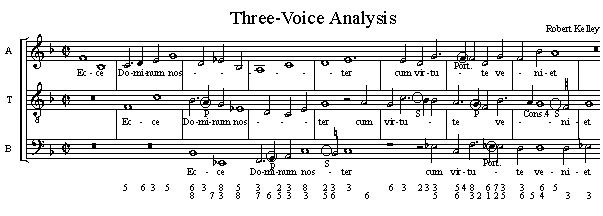16th-Century Analysis Technique
In analyizing music written in the 16th-century style, one does not generally use chord analysis, because the music is more centered around proper modal usage, melodic idioms, conventional cadence figures, and consonance. It is therefore more practical to analyze the music in terms of the consonant and dissonant content by looking at the intervals between the voices for any given verticality.
For two-voice texture, the appropriate interval number (taken from the interval chart) is generally placed between the two voices. All dissonant intervals must be explained by circling the dissonant note and labeling its function (See Dissonance Treatment).
 For three-voice texture, the interval between the top two voices is usually not necessary, and the other two intervals are placed below the music (sometimes in between staves). This is called "Double Analysis":
For three-voice texture, the interval between the top two voices is usually not necessary, and the other two intervals are placed below the music (sometimes in between staves). This is called "Double Analysis":
 For four-voice texture, more than four parts, and polychoral style, the same procedure is followed, analyzing intervals above the bass and placing them below the music (giving figured bass, as it were).
For four-voice texture, more than four parts, and polychoral style, the same procedure is followed, analyzing intervals above the bass and placing them below the music (giving figured bass, as it were).
Special cases are as follows:
- Basso Seguente: Intervals are always analyzed from the lowest sounding pitch
- As seen in the three-voice example above, when the lowest voice has a rest, the next highest voice is the "temporary bass"
- Voice crossing is relatively common in this style, and sometimes the lowest part is not the lowest sounding voice
- Triple Analysis: Sometimes the consonance of the intervals between the upper voices is necessary. The cases in which one must use "Triple Analysis" are:
- Whenever the lowest note is dissonant the upper voices must be consonant with one another
- When a another voice skips against a passing tone it must be consonant both with the passing tone and the sustaining voice.
- When both a fifth (5) and a sixth (6) are present above the bass in a four-(or more) voice texture, all voices except the 6 must be consonant with the 5.
- Whenever there are simultaneous black notes in two or more voices, they all must be consonant with each other
- Whenever there are two simultaneous passing tones, they must be consonant with each other
Return to 16th-Century Counterpoint Study Guide


